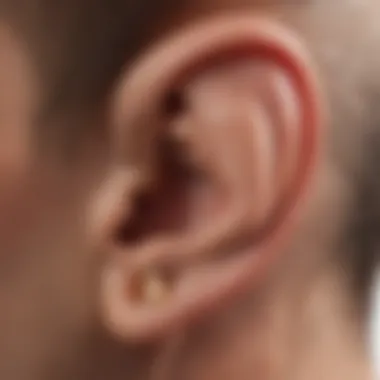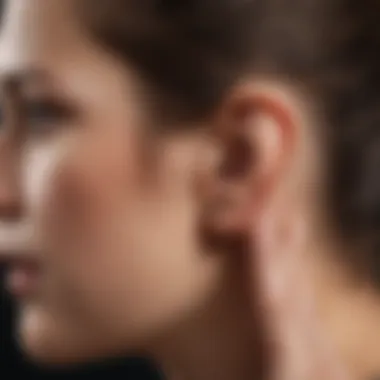Causas de Tinnitus: Un Análisis Exhaustivo


Intro
Tinnitus, often described as a ringing, buzzing, or hissing sound in the ears, is more than just a nuisance. For many, it symbolizes a persistent challenge that affects daily life and well-being. This condition does not discriminate; it touches the lives of millions across different ages and backgrounds. So, what lies beneath this seemingly simple phenomenon?
The causes of tinnitus are as diverse as the individuals who experience it. Understanding these causes is essential, not merely for better management but also for addressing underlying medical or psychological issues that may exacerbate the condition. It can be likened to peeling an onion—many layers must be dissected to reach the core. This article delves deep into the ailments of tinnitus, uncovering both the physical and psychological contributors that enable this condition to flourish.
In the following sections, we will examine key findings regarding underlying conditions, the impact of aging, loud noise exposure, and the psychological elements that intertwine with bodily sensations. Unlike just brushing the surface, this thorough analysis will provide a resource that aims to illuminate the often misconceived aspects of tinnitus. Understanding its diverse origins not only broadens our perspective but equips readers with the knowledge to confront and mitigate the impacts of this ailment.
Introducción al Tinnitus
The topic of tinnitus carries a weight of significance beyond what many might initially perceive. Tinnitus, often described simply as "ringing in the ears," encapsulates a myriad of experiences that individuals endure. These sounds may vary widely – from hissing or buzzing to pulsating tones that can be unsettling. Understanding tinnitus goes beyond recognize it as an auditory inconvenience; it demands a deep dive into its far-reaching implications on mental health, quality of life, and even productivity.
Modern life presents a handful of factors that could trigger or exacerbate this condition. With increasing noise pollution, an aging population, and the continuous use of headphones, we find ourselves in a perfect storm for hearing issues. The importance of this segment of the article focuses strongly on establishing a foundational knowledge of tinnitus as we explore its causes thoroughly throughout this analysis.
Also, there’s an absence of awareness about tinnitus prevalent among professionals in various fields, including health care practitioners not specializing in audiology. It’s essential that they grasp its nuances to provide adequate responses and support for patients.
"Tinnitus serves as a subtle reminder of how delicate our auditory system is, highlighting the need for awareness and proactive measures."
This article will guide readers through the various dimensions of tinnitus, melding scientific insights with relevant anecdotes. By dissecting this condition's definition and prevalence, we aim to build comprehension that transcends mere acknowledgment, paving the way for better management, treatment approaches, and support systems for those affected.
Fisiología del O�ído
Understanding the physiology of the ear is crucial when delving into the causes of tinnitus. Our ears are not merely passive listeners; they are complex structures, finely tuned to detect sound waves and relay this information to our brain. A well-functioning auditory system is essential for hearing clearly and enjoying the sounds from our environment, whether it’s the laughter of friends or the rustling of leaves on a breezy day. Thus, any disruption to this intricate system can lead to unpleasant experiences such as tinnitus.
Estructura del Oído Humano
The human ear has three main sections: the outer ear, the middle ear, and the inner ear. Each part plays a unique role in how we perceive sound.
- Outer Ear: This includes the part we see, called the pinna, which funnels sound waves into the ear canal. The outer ear also protects the inner parts from dust and debris.
- Middle Ear: Connected to the throat by the Eustachian tube, this section contains three tiny bones known as the ossicles – the malleus, incus, and stapes. These bones amplify vibrations from the eardrum, passing them along to the inner ear.
- Inner Ear: Here lies the cochlea, a spiral-shaped structure filled with fluid. It converts sound vibrations into electrical signals, which the auditory nerve then transmits to the brain for interpretation. This area also houses the vestibular system, crucial for maintaining balance.
Understanding these components not only sheds light on how sound travels but also emphasizes the complexity and delicacy of the ear’s structure. Each part is vital, and damage to any of them can lead to issues like tinnitus.
Mecanismos de Percepción Auditiva
The process of auditory perception is not solely mechanical; it is also heavily reliant on neural processes. Once sound waves reach the inner ear and are transformed into electrical signals, these signals travel along the auditory pathways toward the brain.
- Auditory Processing: Different regions of the brain are involved in interpreting these signals, identifying everything from pitch to volume. For instance, the auditory cortex is primarily responsible for processing sounds, while the limbic system may associate these sounds with emotions or memories.
- Central Auditory Nervous System: This system's complexity becomes relevant when discussing tinnitus. Sometimes the brain's response can become heightened or altered, resulting in the perception of sound where none exists.
These mechanisms tell us how intertwined our perceptions of sound and neurological responses are. They work hand-in-hand, and when either system falters, unwanted experiences like tinnitus may arise.
"A deeper understanding of ear physiology shines a light on the interconnectedness of hearing and perception, revealing how easily our auditory experiences can become disrupted."
Understanding these elements provides not only a basis for grasping the physiological underpinnings of tinnitus but also an appreciation for the astonishing capabilities of the human auditory system.
Causas Físicas del Tinnitus
Understanding the physical causes of tinnitus is fundamental in unraveling the complexities of this often perplexing condition. When people experience tinnitus, it is typically not just a symptom but rather a manifestation that can stem from various underlying factors. Identifying these triggers can pave the way for appropriate interventions and management strategies. Furthermore, exploring these physical causes allows for a better comprehension of the relationship between auditory health and overall wellness. Below we delve into significant contributors to tinnitus, emphasizing their implications and the underlying mechanisms.
Lesiones Auditivas
Auditory injuries serve as one of the leading causes of tinnitus. When the delicate structures of the inner ear sustain damage, it can disrupt normal auditory functions. This damage may come from a range of sources, such as prolonged exposure to loud noise—think of the high decibels at a rock concert or industrial settings without adequate ear protection. Moreover, injuries might also stem from sudden loud sounds, like explosions or gunshots, which can be jarring enough to create auditory trauma.
Patients often report a ringing or buzzing in their ears following such incidents. The hair cells in the cochlea, crucial for sound perception, may lose their functionality, leading to misfiring signals that the brain interprets as sound even in absence of external stimuli.
Enfermedades del Oído Interno


Conditions affecting the inner ear can profoundly impact tinnitus. Meniere's disease, for example, disrupts the fluid balance within the ear, and many individuals with this condition report persistent tinnitus alongside episodes of vertigo and hearing loss. This interrelatedness highlights how diseases in the auditory system can exacerbate or trigger tinnitus symptoms.
Additionally, infections such as labyrinthitis can lead to inflammation of the inner ear structures. This inflammatory response can often heighten the perception of tinnitus alongside other auditory disturbances. Understanding these conditions is crucial for any healthcare provider when evaluating a patient presenting with tinnitus symptoms.
La Relación con el Ruido Ambiental
Environmental noise has a significant role in the onset of tinnitus. The relationship between constant exposure to background noise and auditory health cannot be overstated. Many individuals reside in urban areas where traffic sounds, construction noise, and other persistent disturbances are part of daily life.
Chronic exposure to such environments can lead to gradual hearing loss, a condition that is strongly correlated with tinnitus. The auditory system may begin to perceive these external sounds in ways that result in persistent internal noises—this is often perceived as ringing or buzzing. Furthermore, the psychological impact of living in a noisy environment can amplify the sense of tinnitus, creating a feedback loop that is difficult to escape.
Impacto del Envejecimiento
Aging naturally brings about physiological changes that can contribute to auditory disturbances. As we age, there is a gradual loss of sensory cells within the inner ear, and this degeneration often correlates with an increase in tinnitus symptoms. The nuanced interplay between aging-related hearing loss and tinnitus warrants particular attention, especially for the elderly population.
In fact, studies indicate that almost one in three older adults experiences some level of tinnitus. This statistic underscores the necessity for healthcare providers to recognize the implications of aging on auditory health. As part of the aging process, the brain also undergoes changes in neural processing, which can further skew auditory perceptions, making tinnitus more pronounced.
Understanding the intricacies of physical causes is key to effective tinnitus management, particularly as auditory health is tightly woven into overall well-being.
In summary, recognizing the physical causes of tinnitus—whether they stem from auditory injuries, diseases of the inner ear, environmental influences, or the aging process—provides invaluable insights. By addressing these elements, we can formulate effective strategies for prevention and treatment, helping those affected to navigate the challenges posed by this condition.
Condiciones édicas Asociadas
Understanding the medical conditions associated with tinnitus is crucial, as it reveals how various health issues can intertwine with hearing phenomena. Many individuals grappling with tinnitus often overlook underlying medical factors. By recognizing these associations, one can glean insights that could improve both diagnosis and treatment options. The following sections will delve into specific categories, including vascular disorders, neurological afflictions, and the effects of medication on hearing.
Trastornos Vasculares
Vascular disorders can significantly influence auditory perception, often leading to the experience of ringing or buzzing in the ears. Conditions such as hypertension and atherosclerosis can affect the blood flow to the inner ear. As blood vessels stiffen or narrow due to plaque buildup, it can create a disturbance in normal auditory processing.
The connection between fluctuating blood pressure and tinnitus is noteworthy. Elevated blood pressure not only raises the risk of heart disease but can also exacerbate the sounds people hear. More interestingly, individuals might notice that tinnitus becomes more pronounced during stressful situations, whereby anxiety raises blood pressure even further.
Key Considerations:
- Regular monitoring of blood pressure can be beneficial.
- Maintaining a healthy diet and engaging in physical activity may help manage blood pressure levels.
"It's often the little things, like high blood pressure, that can lead to the biggest noise in our ears."
Such understandings underline the importance of addressing these underlying disorders holistically. Individuals experiencing tinnitus may need to consult with healthcare professionals to analyze potential vascular implications.
Afecciones Neurológicas
Neurological conditions present another layer of complexity when discussing the causes of tinnitus. Disorders such as multiple sclerosis or acoustic neuroma can lead to auditory disturbances. When the auditory pathways in the brain are compromised, one might experience altered perceptions of sound.
In the case of an acoustic neuroma, a benign tumor affects the vestibulocochlear nerve, which plays a significant role in hearing and balance. This can lead to unilateral tinnitus, or ringing in one ear, which provides a clue about the underlying issue.
Important Factors to Consider:
- Early diagnosis of neurological disorders is essential.
- Continuous monitoring and regular evaluations can make a significant difference in treatment outcomes.
Efectos de Medicamentos
Medications can have unforeseen consequences on auditory health. Certain drugs, particularly ototoxic medications, may lead to hearing disturbances or exacerbate existing tinnitus. Common culprits include non-steroidal anti-inflammatory drugs (NSAIDs), some antibiotics, and cancer treatments such as cisplatin.
The interaction between different medications also should not be taken lightly. Those on multiple prescriptions might face heightened risks for auditory side effects, inflicting changes in perception or new sounds altogether.
To Note:


- Always discuss potential side effects with a healthcare professional before starting a new medication.
- Keeping a record of medications can help healthcare providers see patterns in symptoms.
Understanding these connections allows individuals to navigate their health more effectively, potentially mitigating the frustrating experience of tinnitus. If a medical condition poses challenges, addressing that aspect may help alleviate the associated auditory disturbances. As more research blooms in this field, clearer pathways will open.
Tinnitus often sits at the intersection of many different health issues, making it critical for patients to be aware of how their medical background may impact their auditory experiences. By analyzing and understanding conditions that accompany tinnitus, individuals can better equip themselves with knowledge and strategies that may benefit their overall health.
Factores Psicológicos en el Tinnitus
The psychological factors surrounding tinnitus play a crucial role in understanding the overall experience of individuals suffering from this condition. It’s not merely the physical perception of sound that matters. Instead, how that sound is processed, understood, and experienced emotionally can significantly influence a person's quality of life. As we delve into these factors, we can better identify effective strategies for managing tinnitus, leading to a more comprehensive approach to treatment.
Estrés y Ansiedad
Stress and anxiety can exacerbate tinnitus symptoms, creating a vicious cycle. When someone is already sensitive to the ringing or buzzing sounds in their ears, increased stress levels may heighten their attention to these sensations. It’s almost like turning up the volume on an old radio that’s already struggling to find a stable frequency.
Individuals facing chronic tinnitus may find that stressful situations lead to emotional distress, making their symptoms seem worse. A study highlighted on wikipedia.com revealed that managing stress levels could significantly lower the perception of tinnitus, suggesting that coping mechanisms play a vital role.
Moreover, therapy options like cognitive-behavioral therapy (CBT) show promise in helping people to reduce anxiety related to tinnitus. By addressing distorted thought patterns about their condition, individuals can regain control, ultimately decreasing their perception of distress.
Trastornos del Sueño
Sleep disturbances are a common complaint among those living with tinnitus. The constant perception of sound can interfere with the ability to both fall asleep and stay asleep. This disruption can leave individuals feeling mentally and physically exhausted, which rounds back to intensifying their experience of tinnitus.
Many find themselves lying awake, caught in a loop of frustration and worry about the next day’s responsibilities. According to research available on britannica.com, improving sleep hygiene is essential for managing tinnitus effectively. Suggestions for enhancing sleep might include:
- Maintaining a consistent sleep schedule
- Creating a comfortable sleeping environment
- Utilizing white noise machines or other audio distractions to mask tinnitus
In some cases, sleep therapy may be appropriate to address these disturbances, paving the way for a more restful and pleasant night.
Percepción y Emociones Asociadas
Emotional responses to tinnitus can vary widely among individuals. Some might feel frustration or helplessness, while others may experience anger or sadness. Understanding that these emotions are valid is a significant first step in addressing the condition.
Helping patients understand their emotional responses can be especially useful in clinical settings, as it provides a broader context for discussing treatment options. It’s often beneficial to highlight the connection between the way they feel and their experience of tinnitus. Strategies such as mindfulness and relaxation techniques have shown positive outcomes in helping individuals manage their emotional reactions to the sounds they perceive.
"The sound of tinnitus might be constant, but its impact can shift based on how we perceive it."
By creating a supportive environment where individuals learn to share their experiences and feelings, they can foster resilience, leading to improved coping strategies.
In summary, psychological factors such as stress, sleep disorders, and emotional perceptions are integral to understanding tinnitus. Addressing these facets can significantly impact a person’s overall well-being and enhance their capacity to manage the condition, leading to a better quality of life.
Diagnóstico del Tinnitus
The diagnosis of tinnitus is not merely a procedural formality; it represents a crucial juncture in understanding the intricacies of this condition. Given its subjective nature, tinnitus doesn't show up on any scanner or x-ray. Patients often find themselves at the mercy of their symptoms, which can vary dramatically from one individual to another. This uncertainty can breed frustration and confusion while ensuring a proper diagnosis and tailored management solutions becomes imperative.
By accurately diagnosing tinnitus, healthcare providers can differentiate it from other auditory issues, direct their investigation effectively, and tailor therapeutic approaches. This understanding helps patients manage their condition better, leading to improved quality of life.
Evaluación Auditiva
Auditory evaluation is a fundamental step in diagnosing tinnitus. It involves a series of tests designed to assess an individual’s hearing capabilities and detect any underlying auditory problems. It typically includes an audiometric evaluation, where a patient listens for sounds at various frequencies and volumes to gauge their hearing sensitivity.
During the evaluation, audiologists may use tools such as:
- Pure tone audiometry: This primary test helps determine whether hearing loss is present.
- Speech recognition tests: Assess how well a patient can understand speech in a quiet environment versus background noise.
These assessments are not only pivotal in identifying the level and type of hearing loss but also in understanding the symbiotic relationship between hearing impairment and tinnitus. For many, the evaluation reveals that their tinnitus is associated with specific frequencies where they experience loss, pointing to the auditory system's complexities.


"Understanding hearing levels can shed light on the nature of tinnitus, opening avenues for effective management."
Historia Clínica y étodos de Diagnóstico
The clinical history of a patient plays a pivotal role in diagnosing tinnitus. Physicians will often take a comprehensive history, collecting details about the onset of the symptoms, the perceived sound’s characteristics, and potential triggers or exacerbating factors. This narrative helps paint a broader picture of the individual's experience.
Key aspects to cover in the clinical history include:
- Duration and onset of tinnitus
- Sound characteristics (e.g., ringing, buzzing, hissing)
- Associated symptoms (such as hearing loss or dizziness)
- Any relevant medical conditions or medications that might contribute to tinnitus
Moreover, a variety of diagnostic techniques may be employed alongside history-taking. These can encompass imaging studies like MRIs or CT scans when specific conditions like tumors or vascular malformations are suspected. Though such imaging is rarely indicative of tinnitus directly, it aids in ruling out other serious pathologies.
In summary, diagnosing tinnitus is multifaceted, needing a convergence of auditory evaluations and clinical narratives. Only then can clinicians accurately parse through the complexities of this auditory phenomenon and set patients on a pathway towards effective management.
Tratamientos y Manejo del Tinnitus
The exploration of treatment options and management strategies for tinnitus is crucial, as this condition can profoundly impact one’s quality of life. Individuals experiencing tinnitus often report feelings of frustration and helplessness. It’s important to understand that while no single approach may work for everyone, a combination of medical treatments, alternative therapies, and home management strategies can provide significant relief.
Opciones de Tratamiento édico
When it comes to addressing tinnitus, medical treatments often prioritize the underlying causes or symptoms. Various approaches can include the following:
- Hearing Aids: Many people with tinnitus also experience hearing loss. Hearing aids can amplify external sounds, which may help mask the internal noises that accompany tinnitus.
- Sound Therapy: This method utilizes background noise or soothing sounds to help manage the perception of tinnitus. Devices can generate white noise or nature sounds that provide a distraction.
- Medications: Although there’s no FDA-approved drug specifically for tinnitus, certain antihistamines or antidepressants might help alleviate symptoms for some individuals.
- Cognitive Behavioral Therapy (CBT): This psychological treatment addresses the emotional response to tinnitus, helping individuals develop strategies to cope with stress and anxiety related to the condition.
Terapias Alternativas
For those seeking more holistic approaches, alternative therapies can play a vital role in managing tinnitus. These can include:
- Acupuncture: Some individuals report an improvement in symptoms following acupuncture treatments, although results can vary widely from person to person.
- Ginkgo Biloba: While research results are mixed, some believe that this herbal supplement may improve blood circulation, potentially benefiting tinnitus sufferers.
- Mindfulness and Meditation: Practices focused on breathing and relaxation can help individuals cultivate a more straightforward relationship with their tinnitus, reducing its disruptive effects.
It is important, however, to approach these therapies with caution, keeping in mind the lack of extensive research on their effectiveness.
Estrategias de Manejo en Casa
Self-management can significantly influence how one copes with tinnitus. Here are some practical strategies:
- Maintain a Healthy Lifestyle: Regular exercise, a balanced diet, and proper hydration can aid in overall well-being and potentially lessen tinnitus symptoms.
- Avoid Loud Environments: Protecting one’s ears from unnecessary noise exposure can help prevent further damage.
- Stress Management Techniques: Engaging in hobbies, spending time with friends or family, and exploring relaxation techniques can support mental well-being.
- Keep a Tinnitus Journal: Documenting experiences related to tinnitus can help identify triggers, patterns, and any correlations between lifestyle changes and symptoms.
In summary, finding effective tinnitus treatments and management strategies will likely require a tailored approach. Combining professional medical advice with personal lifestyle adjustments can lead to better outcomes. The journey to manage tinnitus involves careful consideration of various options and a commitment to finding the most appropriate pathway for individual circumstances.
Conclusión
Tinnitus, a condition often misunderstood, demands our attention and critical examination. The importance of understanding the underlying causes cannot be overstated. It affects people from various walks of life, often leaving them struggling with the persistent noise in their ears that has no external source. This article sheds light on the multifaceted nature of tinnitus, weaving a narrative that covers both the physical and psychological factors that contribute to the experience.
Reflexiones Finales sobre Tinnitus
To draw reflections on tinnitus, one must acknowledge that its impacts go beyond mere annoyance. Many individuals report a marked decline in their quality of life, with heightened stress and anxiety often accompanying this condition. The journey to understanding tinnitus starts with recognizing its diverse origins, from physical injuries to emotional states that can intensify the perception of sound.
A thorough exploration of the various causes clarifies misconceptions and opens pathways to better management. Some may view tinnitus as simply a sign of old age, but this is a narrow understanding. Factors like exposure to loud noises, certain medical conditions, and even the medications one takes play pivotal roles.
The conversation can’t be had without emphasizing the importance of seeking appropriate treatment options and therapeutic avenues. This makes it crucial for patients to engage in open dialogues with healthcare providers, fostering environments where treatment is tailored to individual needs.
Direcciones Futuras en la Investigación
Looking ahead, the future of tinnitus research seems both promising and challenges. One significant area is the exploration of the neural pathways involved in auditory processing. Scientists are keen to unravel how the brain may misinterpret signals, leading to that persistent ringing. Additionally, the interplay between psychological factors such as stress and the severity of tinnitus is ripe for exploration.
The role of technology can't be overlooked either. Advanced sound therapy devices and apps that offer masking sounds are on the rise, as is the interest in cognitive therapies that equip patients with coping strategies.
Collaboration among researchers, clinicians, and individuals affected by tinnitus is essential. By sharing experiences and findings, we can illuminate the darkness surrounding this condition.
"Understanding tinnitus is more than just identifying the symptoms; it’s about embracing a holistic view of health that integrates mind, body, and sound."
In synthesizing the insights presented, we reveal that tinnitus is more than just a medical nuisance. It’s a dynamic field of research where enlightenment and relief can emerge through multidisciplinary efforts. As we tread forward, fostering a comprehensive approach is key, ensuring that those affected receive the support, understanding, and advancements necessary to manage their condition effectively.

